Stay ready and protect your family with practical prepping tips for civil unrest. Learn essential strategies, emergency supplies, and mindset shifts to stay safe during uncertain times.
Have you ever wondered how you’d cope if society suddenly unraveled? It’s a sobering thought, but with rising tensions and uncertainty in our world, it’s one we can’t afford to ignore. Civil unrest can strike when we least expect it, turning our familiar surroundings into unfamiliar territory overnight.
As someone who’s embraced the self-sufficient lifestyle, I’ve learned that being prepared isn’t just about stockpiling supplies – it’s about cultivating a mindset of readiness. Did you know that during times of civil unrest, basic services like electricity and water can be disrupted for days or even weeks? That’s why it’s crucial to have a plan in place before chaos erupts. Plus, the food chain supply can be disrupted with shutdowns and delivery trucks being unable to deliver the supplies we all need. Remember when this suddenly happened to us all in 2020? What do you think may happen after the heated upcoming presidential election this fall in 2024? It is always a smart idea to be prepared for anything.
In this post, I’ll explore practical steps you can take to prepare for potential civil unrest. From understanding the risks and creating a comprehensive emergency plan to building a robust supply kit and enhancing your home security I’ll cover all the bases. You’ll also learn about essential skills to develop and the importance of community preparedness. So, let’s get ready to fortify our homes and our peace of mind against whatever challenges may come our way!
This is a pinnable post. Tap or hover over any image in this post to pin to your Pinterest Boards.
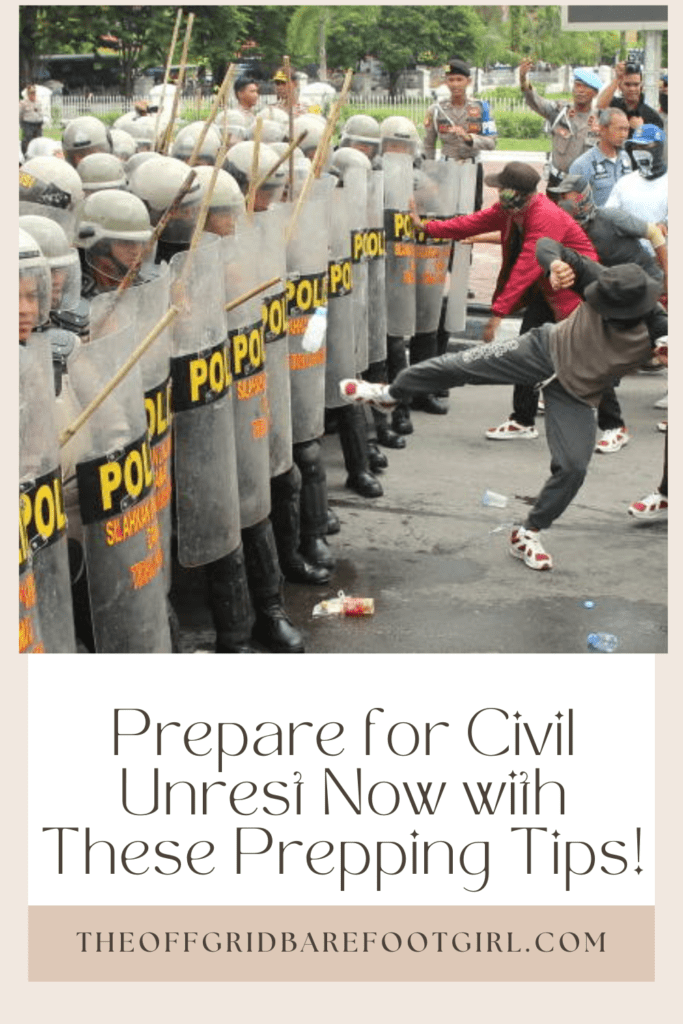
Understanding Civil Unrest and Its Potential Impacts
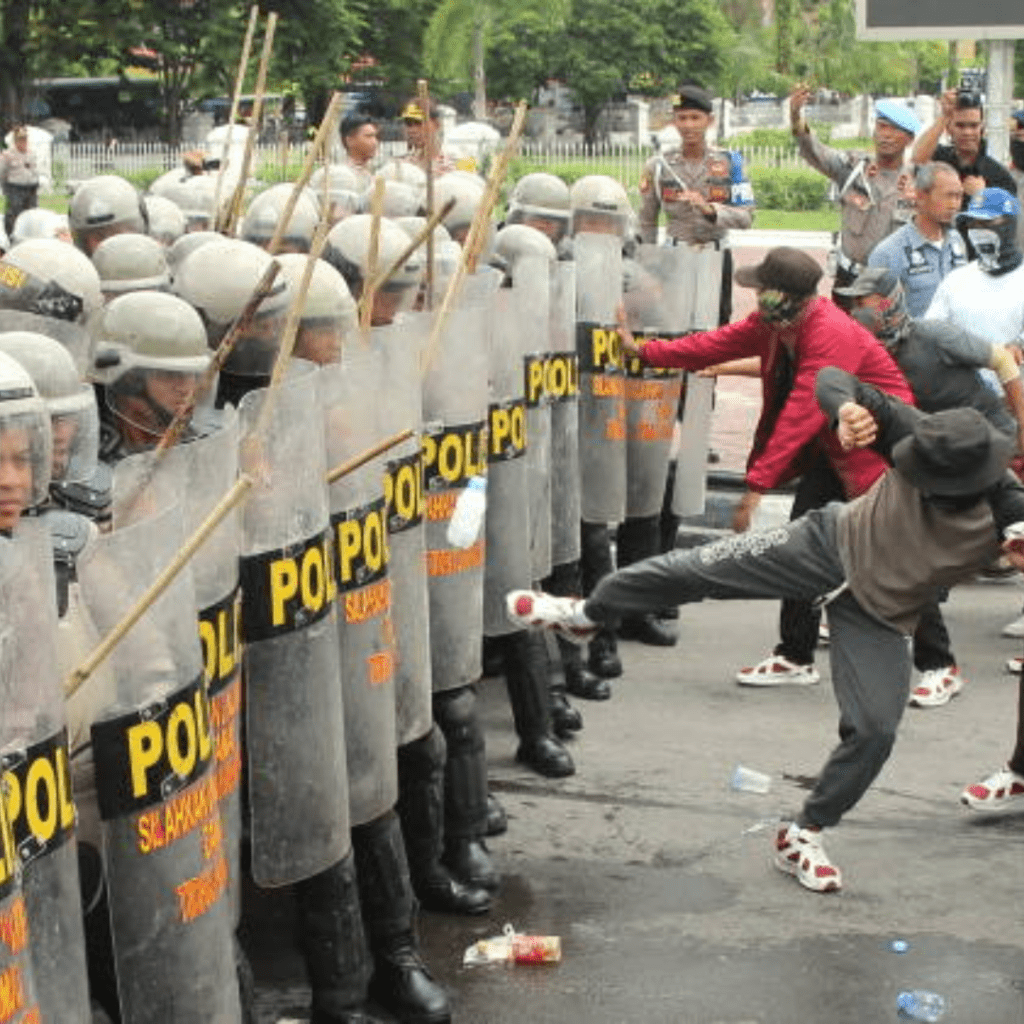
Civil unrest is a term that often sends shivers down our spines, but understanding it is crucial for anyone looking to be prepared for various scenarios. At its core, civil unrest refers to public disturbances involving a large number of people, typically characterized by collective acts of dissent, protest, or even violence. These events can range from peaceful demonstrations to full-scale riots, and they often arise from social, economic, or political tensions within a community or nation.
Throughout history, we’ve seen numerous examples of civil unrest that have shaped societies. From the French Revolution to the more recent Arab Spring, these events have demonstrated the power of collective action. In recent years, we’ve witnessed an uptick in civil unrest globally, with protests over racial injustice, economic inequality, and political grievances becoming increasingly common.
The potential consequences of civil unrest can be far-reaching for both individuals and communities. On a personal level, you might face:
- Disruptions to daily life and routines.
- Limited access to essential supplies and services.
- Potential physical danger if caught in the midst of violent protests.
- Property damage or loss.
For communities, the impacts can be even more severe:
- Economic downturns due to business closures and reduced tourism.
- Strained relationships between law enforcement and citizens.
- Long-lasting social and political divisions.
- Overwhelmed emergency services and healthcare systems.
As someone who values self-sufficiency, it’s important to recognize that civil unrest can affect even the most prepared individuals. While we can’t always predict when or where unrest might occur, we can take steps to mitigate its impact on our lives.
Being aware of local and national issues that could potentially spark unrest is a good starting point. Stay informed through reliable news sources, but be cautious of information overload or sensationalized reporting that might increase anxiety. Building strong community ties can also be invaluable during times of unrest, as neighbors can look out for each other and share resources.
Remember, preparation isn’t about living in fear; it’s about empowering ourselves to face challenges with confidence. By understanding civil unrest and its potential impacts, we can make informed decisions about how to protect ourselves, our loved ones, and our communities. As we continue to explore prepping strategies, keep in mind that knowledge and preparedness are your best defenses against the uncertainties that civil unrest can bring.
Assessing Your Personal Risk and Vulnerabilities
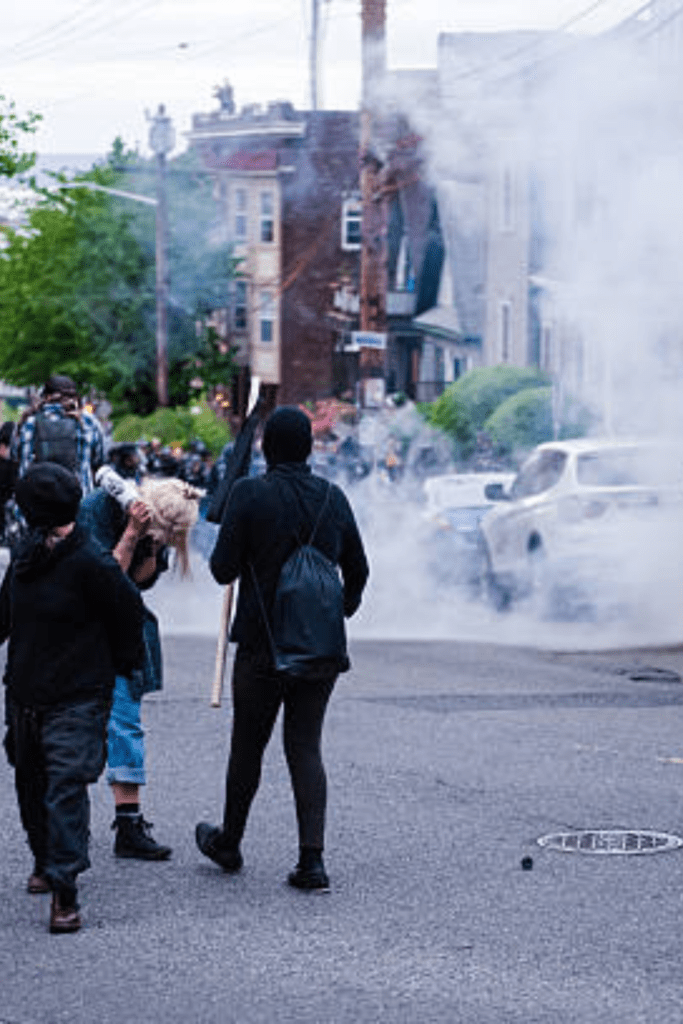
When it comes to preparing for civil unrest, one of the most crucial steps is assessing your personal risk and vulnerabilities. This process helps you understand your unique situation and tailor your prepping efforts accordingly.
Let’s start by evaluating your location and surroundings. Take a good look at your neighborhood, town, or city. Are you in an urban area prone to protests or riots? Or perhaps you’re in a rural setting where isolation could be a concern? Consider factors like population density, proximity to government buildings or potential protest sites, and the general political climate of your area.
Next, it’s time to identify potential threats specific to your location. This could include anything from social unrest due to economic factors to natural disasters that might trigger widespread panic. For urban dwellers, think about the risk of looting or property damage. If you’re in a more remote area, consider how supply chain disruptions might affect you. Don’t forget to factor in your local infrastructure – how reliable are your power and water supplies?
Creating Personalised Risk Assessments and Circumstances
Creating a personalized risk assessment is where we bring it all together. Start by listing out the threats you’ve identified and rank them based on likelihood and potential impact. For example, if you live in a flood-prone area, that might be a high-priority concern. On the other hand, if you’re in a stable region with a strong community, your risks might be lower.
Consider your personal circumstances too. Do you have dependents or older family members to care for? Any medical conditions that require regular medication? These factors can significantly influence your preparedness needs.
Remember, this assessment isn’t about paranoia – it’s about being realistic and proactive. By understanding your unique situation, you can focus your efforts where they’ll have the most impact. Maybe you’ll realize you need to beef up your home security, or perhaps you’ll decide to stock up on specific supplies that suit your circumstances.
As you go through this process, don’t be afraid to reach out to like-minded neighbors or join local prepping groups. Sometimes, an outside perspective can help you spot vulnerabilities you might have overlooked. Plus, building a network of prepared individuals can be a valuable resource in itself.
By taking the time to thoroughly assess your risks and vulnerabilities, you’re laying a solid foundation for your prepping efforts. It’s not always the most exciting part of preparedness, but it’s undoubtedly one of the most important. So grab a notebook, take a walk around your property and home, and start thinking critically about your situation. Your future self will thank you for it!
Developing a Comprehensive Emergency Plan
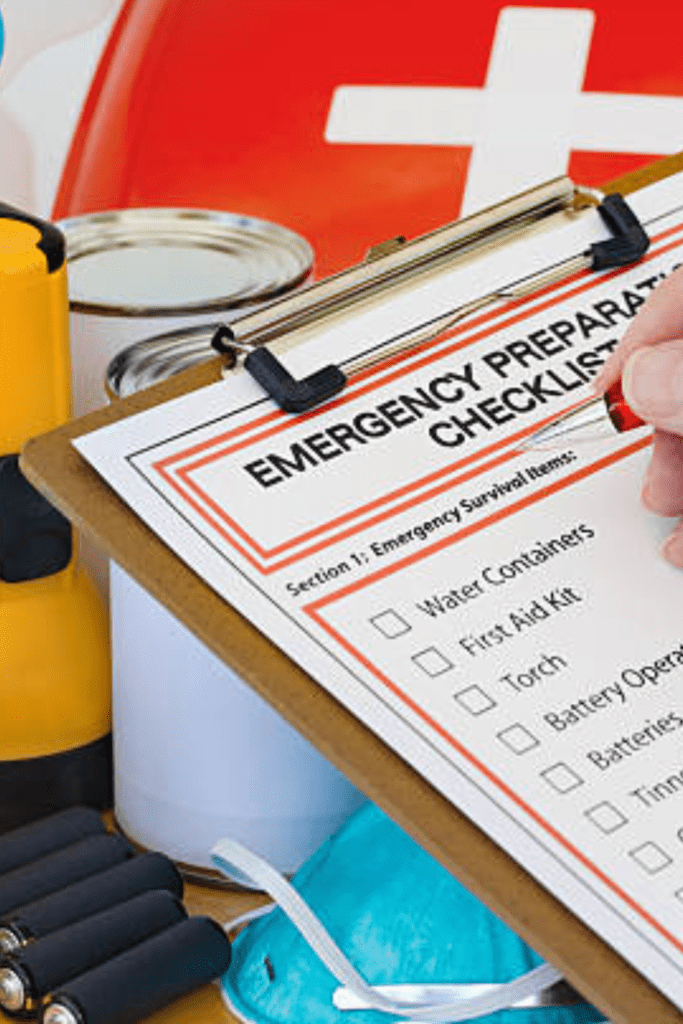
When it comes to preparing for civil unrest, having a comprehensive emergency plan is crucial. As someone who’s spent years honing my self-sufficiency skills, I can’t stress enough how important it is to be ready for anything. Let’s discuss the key components of a solid emergency plan.
Establishing Communication Protocols
In times of crisis, staying connected with your loved ones is paramount. Set up a family communication plan that includes:
- A designated out-of-area contact person.
- Alternative methods of communication (e.g., walkie-talkies, ham radio).
- A list of important phone numbers and addresses.
Remember to practice your communication plan regularly. It’s not enough to just have one; you need to be familiar with it when the time comes to use it.
I have written helpful information regarding communication for emergencies.
Why You Need Ham Radio Aerials for Your Survival Communication!
Designating Safe Meeting Points
Identify multiple safe meeting points for your family or group:
- A primary location near your home.
- A secondary location in case the first is inaccessible.
- An out-of-town location if evacuation is necessary.
Make sure everyone knows these locations and how to get there. Consider factors like accessibility, safety, and available resources when choosing your meeting points.
Creating Evacuation Routes and Alternatives
Map out several evacuation routes from your home, workplace, and other frequently visited locations. Keep in mind that during civil unrest, main roads might be blocked or dangerous. Your evacuation plan should include:
- Primary and secondary routes.
- Alternative modes of transportation.
- A bug-out bag for each family member.
- A list of essential items to grab if time allows.
It’s wise to practice these routes occasionally, especially the less familiar ones. You don’t want to be figuring out directions in the heat of the moment.
Remember, a comprehensive emergency plan is like a well-tended garden – it needs regular attention and updates to remain effective. As you work on your plan, involve your family or group in the process. This ensures everyone understands their role and responsibilities during an emergency.
By taking the time to develop and practice your emergency plan now, you’ll be better prepared to face whatever challenges may come. Stay safe, stay prepared, and keep honing those self-reliance skills!
Building and Maintaining an Emergency Supply Kit
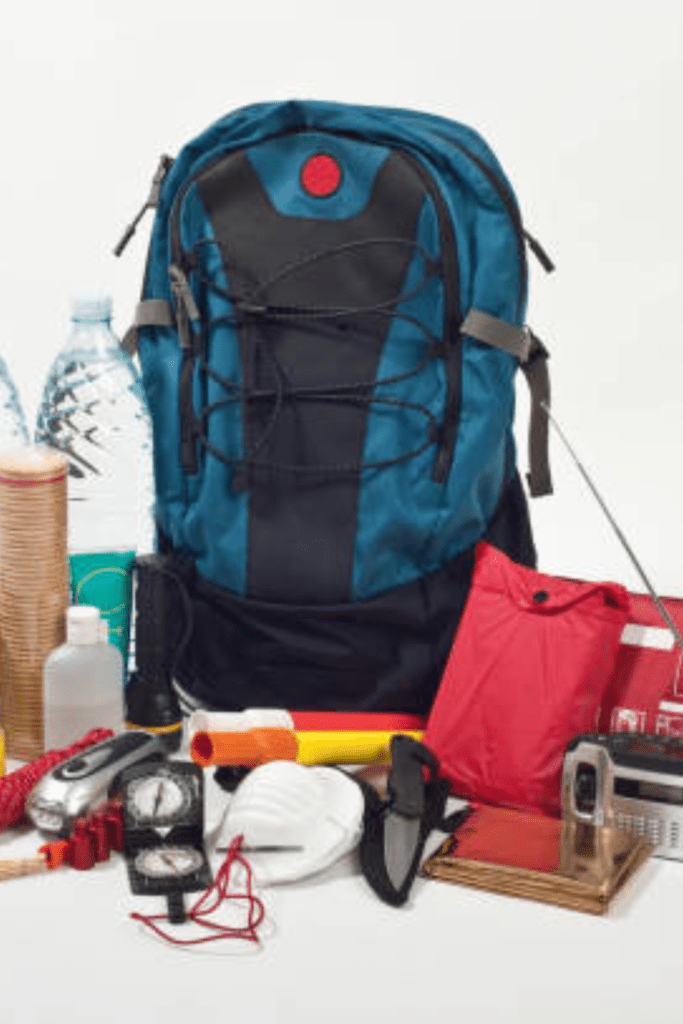
When it comes to prepping for civil unrest, one of the most crucial steps is building and maintaining a robust emergency supply kit. As someone who’s lived a self-sufficient lifestyle for years, I can’t stress enough how important it is to be prepared for any scenario.
Let’s start with the essentials: food and water. Your kit should include non-perishable foods that are easy to prepare and provide balanced nutrition. Think canned goods, dried beans, rice, and energy bars. Don’t forget a manual can opener! For water, aim for at least one gallon per person per day, for a minimum of three days. I always keep water purification tablets or a portable filter on hand, just in case.
First Aid and Medical Necessities:
- Bandages and gauze.
- Antiseptic wipes and ointment.
- Pain relievers and any prescription medications.
- Tweezers and scissors.
- Emergency blanket.
Remember to regularly check expiration dates and replace items as needed. It’s also wise to include a first aid manual and familiarize yourself with basic medical procedures.
When it comes to tools and equipment, think of versatility. Some must-haves include:
- A multi-tool or Swiss Army knife.
- Flashlights and extra batteries (or better yet, a hand-crank flashlight).
- Duct tape.
- Rope or paracord.
- Matches in a waterproof container.
- A battery-powered or hand-crank radio.
Don’t forget about sanitation! Pack items like hand sanitizer, toilet paper, and garbage bags. These might seem trivial now, but they’ll be worth their weight in gold during an emergency.
Also, consider including items specific to your family’s needs. If you have young children, pack diapers and formula. For pets, include food and any medications they might need.
Remember, building an emergency kit isn’t a one-and-done task. It requires regular maintenance and updates. Set a reminder to check your kit every six months, rotating out expired items and reassessing your needs as personal needs may change.
By taking the time to build and maintain a comprehensive emergency supply kit, you’re not just preparing for civil unrest – you’re investing in peace of mind for whatever challenges may come your way. Here are some more ideas to help you prepare that I have written in my other posts.
- Crafting the Ultimate Emergency Action Plan for Your Family
- The Best Portable Generators By Generac
- Bugout Bags and Survival Training Course with Grid Down Consulting!
- Bug In and Survive a Grid Down: Survival Training Course!
- Get These Vital Emergency Survival Equipment Now!
- Get Lockdown Ready: Best Dollar Tree Survival Items
- Thirsty for Survival: Expert Guide to Emergency Water Prep Tactics
- Practical Pantry Prepper: Essential Guide
- What Should Be in A 72-Hour Survival Kit?
- Buy or Die: Prepper Items You Need Now
Enhancing Home Security and Fortification

When it comes to preparing for civil unrest, enhancing your home security and fortification is crucial. I learned a thing or two about keeping my homestead safe when I was growing up in a remote area. Let’s discuss some practical ways to protect your home and loved ones.
Reinforcing Entry Points
Your doors and windows are the first line of defense against intruders. Start by upgrading to solid core doors with deadbolts and reinforced frames. For windows, consider installing security film or bars. Don’t forget about basement windows and skylights – these are often overlooked, but can be vulnerable entry points.
Remember, a determined intruder might try to break through walls, so consider reinforcing them with plywood or metal sheets, especially in less visible areas of your home. I am thankful to have a brick home!
Installing Security Systems and Surveillance
If you are living in a remote area, solar-powered cameras and motion-activated lights can deter potential threats and alert you to any suspicious activity. Consider installing a perimeter alarm system using tripwires or sensors to give you early warning of approaching intruders.
For those with access to more technology, smart home security systems can provide real-time monitoring and alerts to your phone. However, always have a backup plan in case of power or internet outages.
Creating Safe Rooms or Shelters
Having a designated safe space within your home can provide crucial protection during emergencies. This could be as simple as reinforcing a closet or as elaborate as building a hidden bunker. The key is to make it easily accessible, well-stocked with supplies, and difficult for intruders to breach.
When designing your safe room, consider:
- Reinforced walls and door.
- Communication devices (e.g., hand-crank radio).
- Emergency food and water supplies.
- First aid kit and necessary medications.
- Weapons for self-defense (if you’re comfortable and trained in their use).
Remember, the goal is to create a space where you can safely wait out a threat or call for help.
By implementing these measures, you’ll significantly improve your home’s security and your family’s safety during times of civil unrest. However, it’s important to regularly review and update your security plans. Threats can evolve, and so should your preparations. I have written a post regarding the best safe rooms for your family to escape the chaos that you can add to your home for safety.
The Best Safe Rooms for Your Family: Escape the Chaos!
Acquiring and Improving Necessary Skills
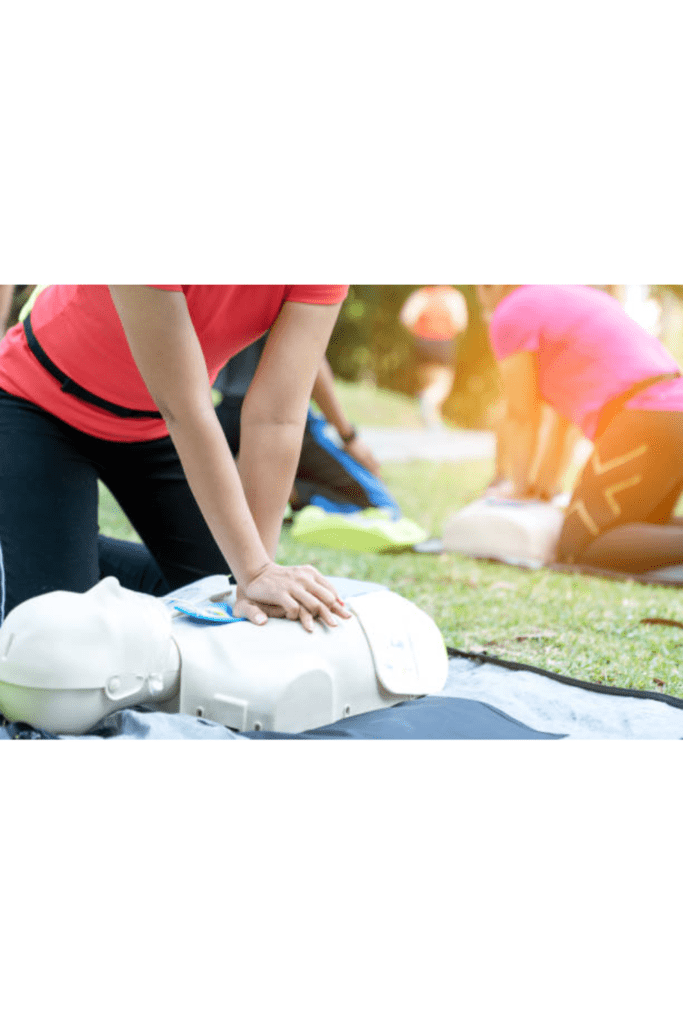
When it comes to preparing for civil unrest, acquiring and improving necessary skills is just as important as stockpiling supplies. As someone who’s trained in survival and first-aid for years, I’ve learned firsthand the value of being self-reliant. Let’s explore some essential skills you should focus on developing.
First Aid and Medical Training
In times of civil unrest, access to medical care may be limited. That’s why it’s crucial to have a solid foundation in first aid and basic medical skills. Consider taking a comprehensive first-aid course that covers:
- CPR and rescue breathing.
- Treating wounds and controlling bleeding.
- Recognizing and managing shock.
- Dealing with fractures and sprains.
- Identifying and treating common illnesses.
Don’t forget to assemble a well-stocked first aid kit and familiarize yourself with each item. Practice your skills regularly to keep them sharp.
Self-Defense and Situational Awareness
Being able to protect yourself and your loved ones is paramount during uncertain times. Enroll in self-defense classes to learn effective techniques for various situations. Some key areas to focus on include:
- Basic striking and blocking.
- Escaping from grabs and holds.
- Weapon awareness and disarming techniques.
- De-escalation strategies.
Equally important is developing situational awareness. Train yourself to be constantly aware of your surroundings, identifying potential threats and escape routes. This skill can help you avoid dangerous situations altogether.
Check Out My Survival Training Courses Offered By The Best Survival Experts!
When society’s infrastructure is compromised, knowing how to survive in various environments becomes invaluable. Some essential skills to develop include:
- Fire starting and maintenance.
- Water procurement and purification.
- Shelter building.
- Foraging for edible plants.
- Basic hunting and trapping.
Navigation skills are also crucial. Learn how to read maps and use a compass, as GPS devices may not always be reliable. Familiarize yourself with the area around your home and potential bug-out locations.
Remember, skills are like muscles – they need regular exercise to stay strong. Make time to practice these skills regularly, and consider joining local groups or clubs focused on survival and preparedness. By honing these abilities, you’ll be better equipped to handle whatever challenges may arise during times of civil unrest.
Check Out My Survival Training Courses Offered By The Best Survival Experts!
Establishing a Support Network and Community Preparedness
When it comes to preparing for civil unrest, establishing a strong support network and fostering community preparedness are essential steps that can make all the difference. As someone who’s embraced the self-sufficiency lifestyle, I’ve learned firsthand the importance of building connections and working together with like-minded individuals.
Connecting with Like-Minded Individuals
One of the most effective ways to strengthen your preparedness is by connecting with others who share your values and concerns. Seek out local prepper groups, homesteading communities, or online forums where you can exchange ideas and experiences. These connections not only provide emotional support, but can also be invaluable sources of knowledge and resources.
Consider organizing regular meetups or skill-sharing sessions with your newfound network. You might be surprised at how much you can learn from others – whether it’s canning techniques, basic first aid, or tips for growing a thriving garden in challenging conditions.
Participating In Community Preparedness Initiatives
Getting involved in community-wide preparedness efforts is another crucial step. Many towns and cities have emergency response teams or disaster preparedness committees that welcome volunteers. By participating in these initiatives, you’ll gain valuable skills and insights while contributing to the overall resilience of your community.
Look for opportunities to attend local emergency preparedness workshops or training sessions. These events often cover topics like basic first aid, emergency communication, and disaster response protocols – all of which can be incredibly useful in times of civil unrest.
Forming Mutual Aid Agreements
Establishing mutual aid agreements with neighbors and community members is a proactive way to ensure everyone’s needs are met during challenging times. These informal arrangements can cover anything from sharing resources and skills to providing temporary shelter or assistance with childcare.
To start, have open conversations with trusted neighbors about your shared concerns and how you might support each other. Consider creating a neighborhood inventory of skills and resources, so everyone knows who to turn to for specific needs. For example, if you’re an experienced gardener, you might offer to help others start their vegetable patches in exchange for other services or goods.
Remember, building a strong support network and fostering community preparedness isn’t just about surviving potential civil unrest – it’s about creating a more resilient and connected community for the long term. By working together and sharing our knowledge and resources, we can face whatever challenges come our way with greater confidence and strength.
Conclusion
As we’ve explored, preparing for civil unrest is about more than just stockpiling supplies. It’s about understanding the risks, developing a solid plan, and building the skills and networks needed to weather any storm. By assessing your vulnerabilities, fortifying your home, and creating a comprehensive emergency kit, you’re taking important steps toward self-reliance and security.
Remember, true preparedness is an ongoing journey. Keep learning, stay informed, and continuously refine your plans. Reach out to your community and build those vital support networks – after all, we’re stronger together!
While the thought of civil unrest can be daunting, being prepared empowers us to face challenges with confidence. By taking action now, we’re not just safeguarding ourselves, but also contributing to the resilience of our communities. So, take that first step today, whether it’s starting your emergency kit or learning a new skill. Every small action brings you closer to a more secure future, and that’s something we can all feel good about.
When civil unrest strikes, being self-sufficient on your own land gives you a safe and reliable foundation—learn more in How to Live on Raw Land.
Prepping for civil unrest is just one part of comprehensive safety, and you can explore a complete approach to protecting your family in The Complete Guide to Emergency Preparedness: Everything You Need to Thrive in Any Situation.
Resources: Here are some helpful resources for further information.
- Civil Unrest Resources – By EMS.gov
- Prepping Basics – By The Prepared
- Why Prepping Is Not Just for the Apocalypse – By The Shepherdess
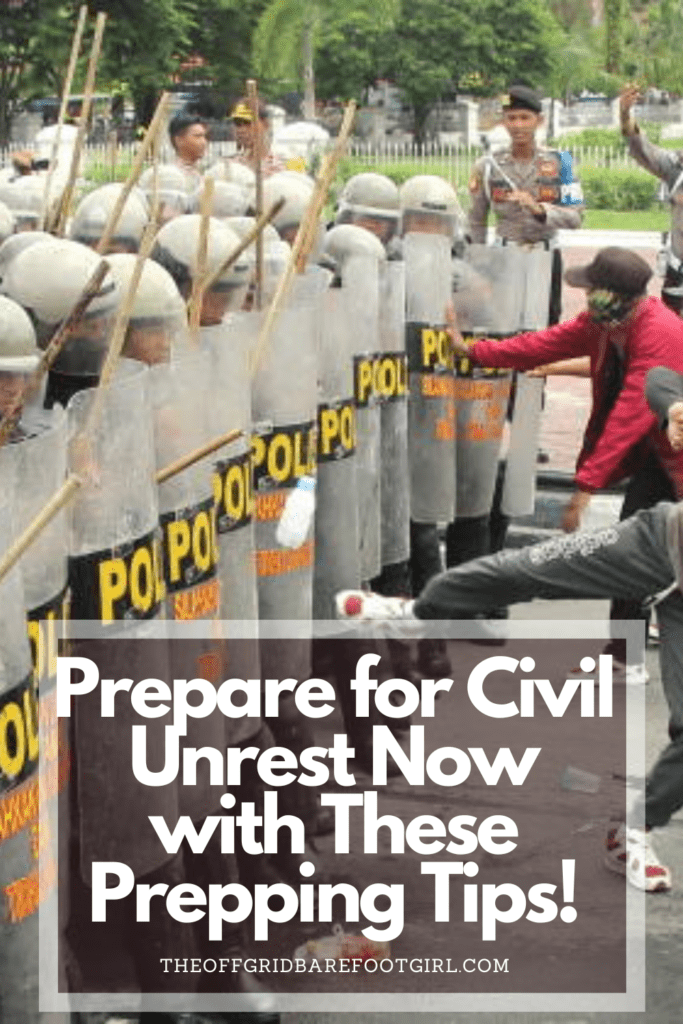
Frequently Asked Questions
1. What essential supplies should I stock up on for civil unrest?
Focus on non-perishable food, clean water, first aid supplies, personal defense items, and basic hygiene products. It’s also wise to have extra medications and important documents ready.
2. How can I secure my home during civil unrest?
Reinforce doors and windows, install security cameras or motion-activated lights, and create a communication plan with family members. Stay informed about local events and avoid high-risk areas.
3. Should I stay or evacuate during civil unrest?
If your area becomes unsafe, it’s best to evacuate if possible. Have an emergency go-bag prepared, know multiple exit routes, and stay updated on local authorities’ recommendations.
4. How can I protect my family without causing panic?
Discuss emergency plans calmly, and involve your family in prepping without creating fear. Practice drills and ensure everyone knows what to do in various situations.
Summary
I hope I have inspired you to help you prepare your family for emergencies with these helpful tips and products. Here are some other links you may be interested in reading!
How to Survive the Silent Killer Carbon Monoxide Poisoning
How to Do Earthquake Drills: Are You Ready to Shake, Rattle, and Roll?
Crafting the Ultimate Emergency Action Plan for Your Family
How to Create a Cozy Home Anytime of the Year!
The Best Portable Generators By Generac
Best Ideas for Backpacking Meals: Fuel Your Adventure!
End Times Headlines: How Prepared Are You Really?
Hiking the High Desert: Survival Tips You Should Never Ignore!
SHTF Planning: How to Survive the High Desert Bootcamp!
Survival Skills Training: Into the Backwoods with a Master Survivalist!
Choosing the Best Survival Cooking Kit: The Ultimate Guide
Survive the Peaks: The Best Avalanche Gear on the Market!
Bug In and Survive a Grid Down: Survival Training Course!
Bugout Bags and Survival Training Course with Grid Down Consulting!
Self-Sufficiency and Survival Posts!
Get These Vital Emergency Survival Equipment Now!
Bartering: How To Negotiate Commodities with Astonishing Results!
Warning: Why You Need Whole Home Water Purification Now!
How to Design Off Grid Power Systems for Your Homestead
How Many Watts Does a Fridge Use? Energy Efficient Guide
The Best States for Off Grid Living: Unplugged and Thriving
Composting Toilet Systems Are Surging: Ditch Your Septic Tank Now!
Are Greywater Tanks the Key to Sustainable Living? Find Out Now!
How to Live Off-Grid: 11 Tips to Survive and Thrive!
Are Survival Food Kits Worth It? The Truth Revealed!
Do You Really Need Faraday Bags? The Shocking Truth Revealed!
The Best Doomsday Preppers Blogs to Follow Now Before SHTF!
The Ultimate Camping Gear Checklist: Everything You Need for an Adventure
The Ultimate Spring Cleaning House Checklist: Deep Clean with Me!
How Supporting Farmer’s Markets Makes a Difference
Eco-Friendly Christmas: How to Have an Eco-Friendly Christmas
How to Winterize Your Home: Prepare for Jack Frost’s Wrath!
Proven Hacks to Make Your Christmas Tree Survive
What Thanksgiving Teaches Us About Survival
Homeless Survival Hacks to Overcome Adversity
More Self-Sufficiency Posts!
Is Your Car Ready for Winter? The Ultimate Checklist for Your Winter Emergency Car Kit
What The Walking Dead Can Teach Us About Survival: The Walking Dead Survival Tactics
Get Lockdown Ready: Best Dollar Tree Survival Items
Understanding Water Purification Methods for Survival: Best Practices Explained
Thirsty for Survival: Expert Guide to Emergency Water Prep Tactics
The Benefits of Urban Homesteading: Revolutionize Your City Life
Practical Pantry Prepper: Essential Guide
How to Grocery Shop Once a Month
What Should Be in A 72-Hour Survival Kit?
Buy or Die: Prepper Items You Need Now
How to Learn 58 Self-Sufficient Skills Right Now
Road to Self-Sufficiency: How to Start Your Journey
If you were encouraged by this post, I invite you to check out my FREE Printables Page for fun free printables, planners, and charts.
ENTER MY FREE Printables Page HERE
Blessings,
The Off Grid Barefoot Girl

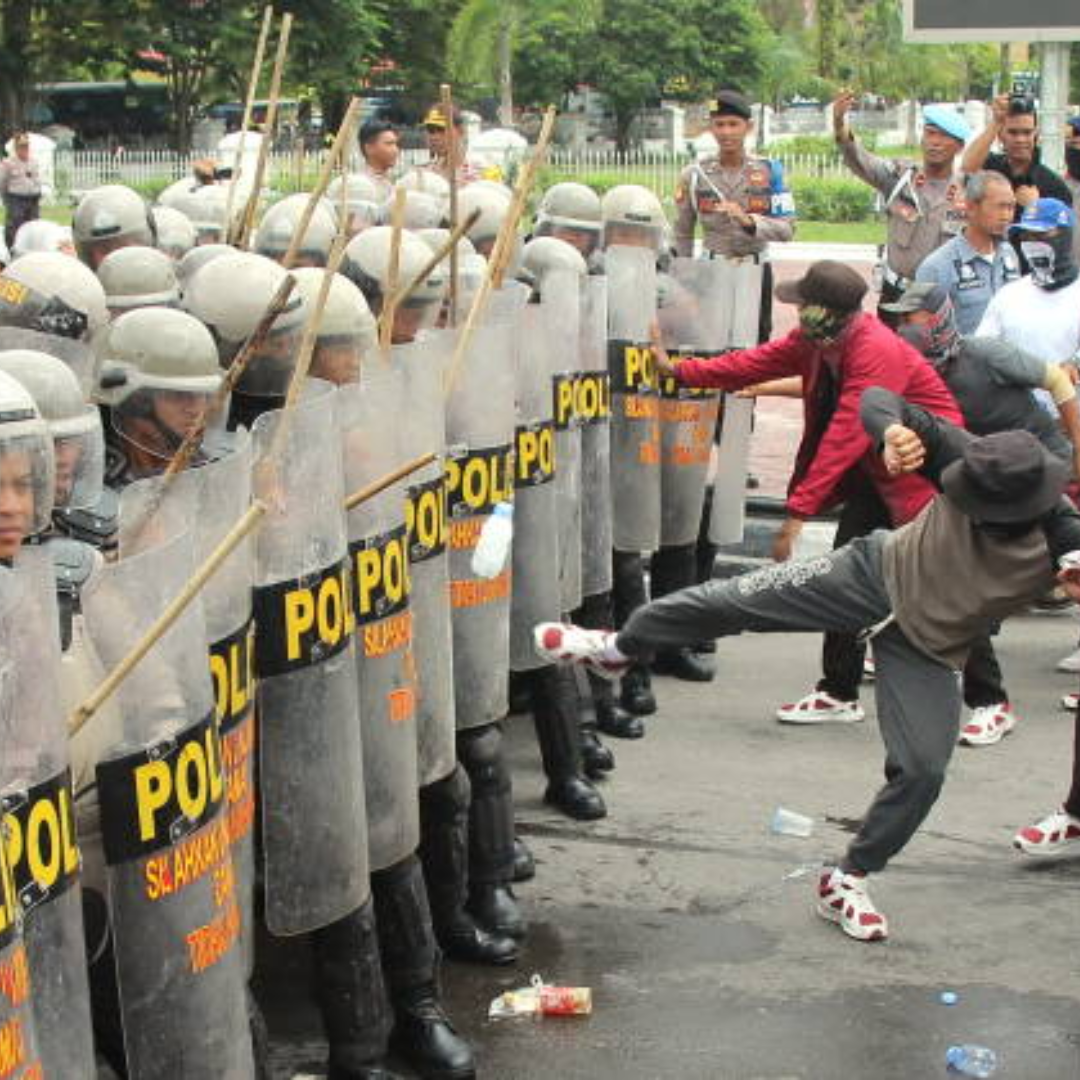




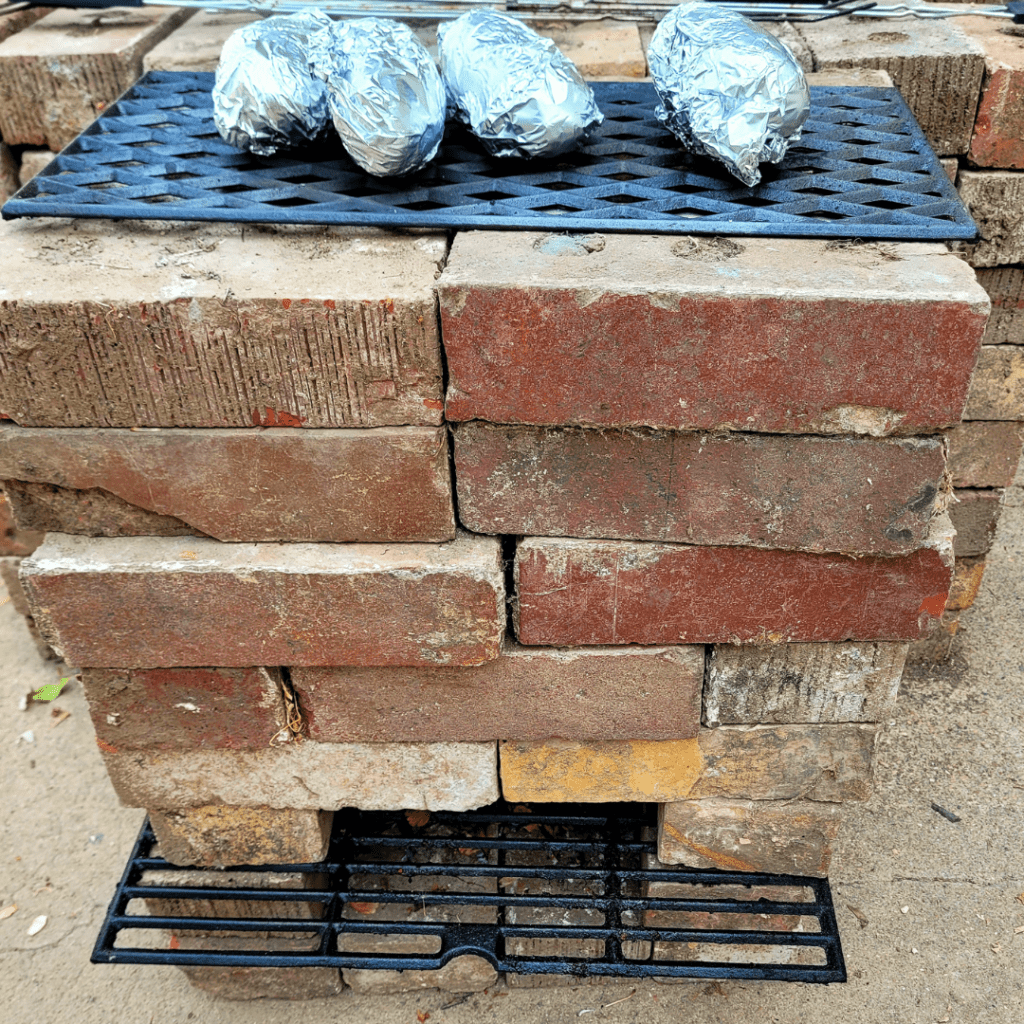
The odds on A nation wide “ARAB SPRING” riot or an EMP attack happening in the U.S. are possibly 1,000,000,000 — 1. So are the chances of NATIONWIDE martial law being declared. If Miami gets hit by a hurricane; they have a valid reason to call out their state’s natl.guard units.
But I do not expect guard units being sent to areas that didn’t get hit by the disaster. Or in states that are 1,000 miles from Florida.
Why are so many people paranoid about NATIONWIDE martial law being declared? Or the U.S. being hit by an EMP attack? There are only two ways an EMP pulse wave can happen: 1) A massive solar flare; or 2) An airborne NUCLEAR weapon being set off.
The U.S. consists of 50 states. The odds of ORGANIZED rioting in all 50 states at the same time are possibly 1,.000,000 — 1. So why do I see so many web articles about civil unrest happening in the U.S. ?
Thanks so much for your thoughtful comment!
You’re right—events like a nationwide “Arab Spring” style riot or an EMP attack affecting all 50 states at once are extremely unlikely. And yes, martial law is generally declared only in very localized situations, like after a hurricane hits a specific area.
That said, prepping isn’t about expecting the worst-case scenario every day—it’s about being ready for whatever might come your way, whether that’s a natural disaster, power outage, or even a short-term disruption in supplies. While a massive EMP or nationwide unrest is rare, smaller-scale emergencies happen regularly and can have a big impact if you’re not prepared.
For example, a hurricane hitting Florida might not affect Montana, but power outages, severe storms, or supply chain hiccups can happen anywhere. Being prepared with food, water, and basic supplies is simply smart, practical living—not paranoia.
At The Off Grid Barefoot Girl, I encourage people to build resilience through simple, doable steps that help families stay safe and comfortable during unexpected challenges—no matter how big or small.
Thanks again for sharing your perspective! I believe awareness and readiness empower us all.
Warmly,
Mindy
The Off Grid Barefoot Girl